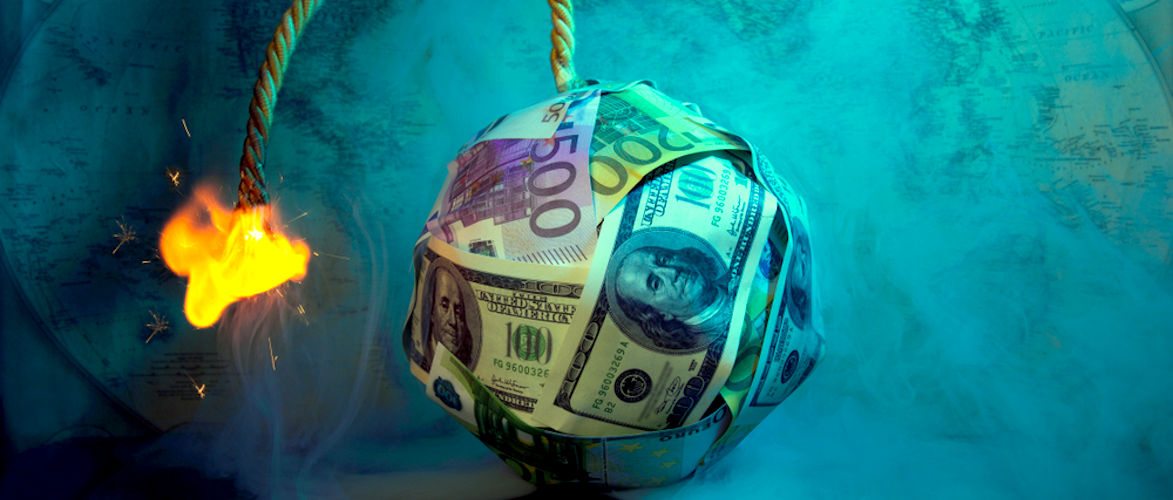How the corona lockdowns are driving many nations into debt crises.
By Christian Kreiß.
In April 2020, the Institute of International Finance, a global association of financial institutions, titled a study “COVID-19 Lights a Fuse”.1The bank lobby organization, which is worried about debt defaults, was referring to the fuse in the debt bomb. For as early as April, global debt amounted to 322 percent of the world’s national product. In the meantime, it has probably risen to over 350 percent, which is impossible to repay in real terms. By way of comparison: When the financial crisis broke out in 2007, debt amounted to around 282 percent of world GDP, which was already unsustainable at that time.2
A study3 published by the IMF in June 2020 states that the largest, strongest and broadest debt increase in the past decade has taken place in developing and emerging countries in the last 50 years. Since 2010, their debt in relation to national product has risen by 60 percentage points to 170 percent of GDP in 2019. Without China, this ratio would have risen by 20 percentage points to 108 percent. The share of government debt held by foreign investors had risen to 43 percent and the share of corporate debt raised in foreign currency from 19 percent of GDP in 2010 to 26 percent in 2018. In the particularly poor countries, the debt level rose from 47 percent in 2010 to 65 percent in 2019.
One fifth of the debts of the manufacturing and service companies in the emerging market economies (excluding China) are currently denominated in foreign currency.4 How are these debts to be repaid by poor countries in the face of a collapsing world economy and world trade shrinking by at least 13 percent,5 when foreign currency is much more difficult to obtain through exports? In addition, more than $20 trillion of debt and bonds will be due by the end of 2020, so they will either have to be repaid or extended through new borrowing, 4.3 trillion of which will be in emerging markets (including China). Of this, $730 billion of debt (including China) is in foreign currency.6 By way of comparison, world GDP, the world’s economic power in 2019 was about $86.6 trillion.7
These are impressive figures. This is why the Wall Street Journal wrote in July 2020 about the world moving ever faster towards a battle over emerging market debt in a way that few have seen before. Significantly, the title of the article was: “Covid’s Next Economic Crisis: Developing-Nation Debt”.8 According to the article, at least 12 emerging markets currently have acute repayment problems or are close to doing so.
As early as April 2020, the 20 leading economies, the G20, decided on a debt moratorium for more than 70 (!) developing countries, which means that the debt no longer needs to be serviced. Ironically, Argentina is a member of the G20 club. Argentina has been insolvent since February 2020 and is currently facing its ninth national bankruptcy.9 By April 2020, 102 countries had already applied to the IMF for emergency loans.10 Some of them did not want to be named because they were afraid of not being able to obtain loans from other parties. 102 countries. That is more than half of the 194 or so countries in the world.11
In short: On the world debt markets, the bond or bond markets, another debt crisis seems to be looming on the horizon, originating from the emerging markets. Even relatively economically strong and large emerging markets like Turkey may be facing significant foreign debt and currency problems. Turkey currently has around 431 billion dollars in gross foreign debt, or 256 billion net foreign debt.12 The Turkish lira is rushing from one low to the next.13 If Turkey were to run into serious debt problems, this could put a heavy burden on some European banks. This does not only apply to Turkey. If turbulence emanates from the emerging markets’ credit and bond markets, this will also affect Europe and other industrialized countries and exacerbate the Corona global economic crisis.
We were able to observe this impressively in the financial crisis of 2007-2009: Securitized debt packages on American real estate have let the debt bomb explode in Europe. As a result, the debt and currency problems of other countries are often ultimately transferred to the core industrialized countries, albeit not with the same force. The way forward is usually via currency crises, such as the Asian financial crisis in the late 1990s. Because of excessive and therefore non-repayable foreign debts, the currencies of certain countries fall into disrepair, currency turbulence on the world markets and distortions in trade flows occur, in concrete terms: declining exports and imports. This is exactly what we need least in the current unstable global economic situation.
The main driver of this “strongest increase in debt in the last 50 years” was essentially the extremely low interest rates in the industrialized countries after the financial crisis of 2007-2009. This drove a lot of investment-seeking money into higher-interest securities. As the Wall Street Journal wrote, Wall Street banks saw the opportunity to open up new markets with higher yields.14 Since John Perkins’ “Confessions of an Economic Hit Man” (first edition in 2006)15 we know that there is also a way to help with lending to developing and emerging countries. In this way, debtor nations can be made dependent and it is easier to get political conditions imposed in favor of Western corporations or Western interests. Incidentally, China seems to take a very similar approach in its lending policy, for example in the Silk Road project, in order to make countries dependent on itself.16
Interesting in this context are the conditions demanded by the IMF and World Bank on Belarus, where emergency aid loans are to be tied to tough economic lockdown measures, which Belarus vehemently rejected.17 These forced lockdown measures would plunge Belarus into a severe economic crisis, just as it was the case with all other countries with tough lockdowns. One might ask how then the debts of the IMF and World Bank would be repaid? A prankster who thinks evil of it.
On the side of the borrowers, corrupt elites often participate in the (evil) “game”. The Wall Street Journal, for example, says of Angola that the country has taken out 8 billion dollars in loans over the last few years to expand water and electricity networks or roads. Of the 26 planned projects, only four have been started.18 This principle that corrupt elites often enrich themselves in the borrower countries is already impressively well described by Perkins in his “Confessions”.
None of this bodes well for the further course of the global economic crisis.
Prof. Dr. Christian Kreiß, born 1962: Studies and doctorate in economics and economic history at the LMU Munich. Nine years of professional activity as a banker, seven of which as an investment banker. Since 2002 professor at the University of Applied Sciences Aalen for Finance and Economics. Three invitations to the German Bundestag as an independent expert (Greens, Left Party, SPD), trade union member at ver.di. Numerous television, radio and magazine interviews, public lectures and publications.
Sources:
1 https://www.iif.com/Portals/0/Files/content/Research/Global%20Debt%20Monitor_April2020.pdf: Covid-19 lights a fuse
2 https://www.heise.de/tp/features/Der-groesste-Wirtschaftsabsturz-der-Neuzeit-4870567.html vom 14.8.2020
3 https://www.imf.org/external/pubs/ft/fandd/2020/06/COVID19-and-debt-in-developing-economies-kose.htm
4 https://www.iif.com/Portals/0/Files/content/Research/Global%20Debt%20Monitor_April2020.pdf: Covid-19 lights a fuse
5 Angaben der World Trade Organization für das Gesamtjahr 2020, vgl. Wall Street Journal 3.8.2020
6 https://www.iif.com/Portals/0/Files/content/Research/Global%20Debt%20Monitor_April2020.pdf: Covid-19 lights a fuse
8 Wall Street Journal 26.7.2020, “Covid’s Next Economic Crisis: Developing-Nation Debt“: https://www.wsj.com/articles/covid-coronavirus-developing-nation-africa-debt-crisis-11595455147 Im Artikel heißt es: „The world is gearing up for a battle over developing-country debt like few it has seen before“
10 SZ 16. April 2020: https://www.sueddeutsche.de/wirtschaft/corona-krise-der-iwf-muss-ran-1.4878552
12 https://www.hurriyet.de/news_tuerkei-hat-im-ausland-rund-384-milliarden-euro-schulden99016_143538521.html
13 https://www.dw.com/de/t%C3%BCrkei-lira-w%C3%A4hrung-absturz/a-54480869; https://tradingeconomics.com/turkey/currency
14 file:///C:/Users/00413/Documents/Hintergrund-Info/wsj%20foreign%20debt%20Covids_next_economic_crisis.pdf : „Wall Street banks saw an opening to new markets offering better returns than the ultralow interest rates in the West.“
15 Perkins, John, Bekenntnisse eines Economic Hit Man – erweiterte Neuausgabe: Unterwegs im Dienst der Wirtschaftsmafia, 2016, Goldmann, München
17 https://www.cashkurs.com/beitrag/Post/weissrussland-iwf-und-weltbank-knuepfen-nothilfekredite-an-harte-lockdown-massnahmen/
18 file:///C:/Users/00413/Documents/Hintergrund-Info/wsj%20foreign%20debt%20Covids_next_economic_crisis.pdf
+++
Thanks to the author for the right to publish.
+++
Image source: Erkipauk / shutterstock
+++
KenFM strives for a broad spectrum of opinions. Opinion articles and guest contributions do not have to reflect the views of the editorial staff.
+++
KenFM now also available as a free app for Android and iOS devices! Via our homepage you can visit the stores of Apple and Google. Here is the link: https://kenfm.de/kenfm-app/
+++
Support us with a subscription: https://www.patreon.com/KenFMde
+++
You like our program? Information about further support possibilities here: https://kenfm.de/support/kenfm-unterstuetzen/
+++
Now you can also support us with Bitcoins.

BitCoin address: 18FpEnH1Dh83GXXGpRNqSoW5TL1z1PZgZK










Kommentare (0)